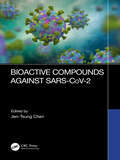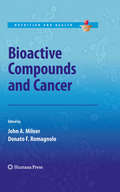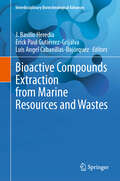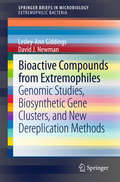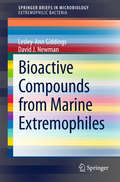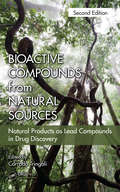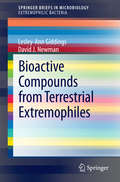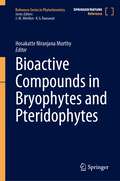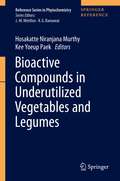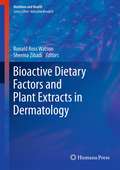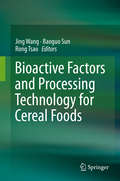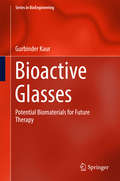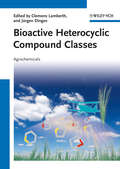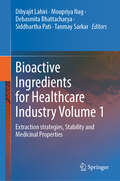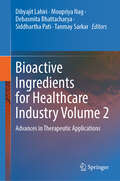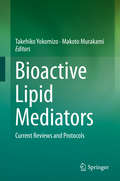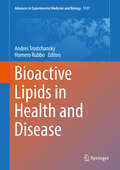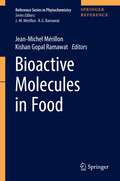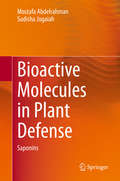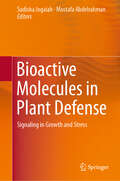- Table View
- List View
Bioactive Compounds Against SARS-CoV-2
by Jen-Tsung ChenCoronaviruses can cause illness, severe disease, and death; for example, Middle East respiratory syndrome (MERS), severe acute respiratory syndrome (SARS), and COVID-19. Vaccine development and antiviral drugs are challenged by the propensity for viral mutations allowing these viruses to evade such therapies. There are a number of bioactive compounds from natural sources, which can exert health benefits and act as antiviral therapies such as anti-inflammation, antioxidative stress, and immune regulation. This book summarizes research on the potential efficacy and underlying mechanisms of bioactive compounds and traditional medicines against SARS-CoV-2. Key Features Summarizes the potential benefits of bioactive therapies for coronaviruses Focuses on COVID-19, but also covers MERS and SARS Provides alternatives to vaccines and other antiviral drugs whose efficacy is reduced by viral mutations Relevant for clinicians and public health officials
Bioactive Compounds and Cancer (Nutrition and Health)
by John A. Milner Donato F. RomagnoloBecause of the wealth of new information generated by the scientific community during the last decade on the role of nutrition on cancer risk, this book provides a forum for presentation and discussion of recent scientific data and highlights a set of dietary recommendations. Bioactive Compounds and Cancer presents chapters that highlight laboratory and clinical findings on how selected nutrients function as signaling molecules and, as such, influence cellular behavior and cancer predisposition. This important compendium focuses on understanding the role of nutrition in cancer biology, the molecular action of bioactive food components and xenobiotics on cancer risk, the role of dietary components in cancer prevention and/or treatment, and nutrition education with the most up to date dietary recommendations that may reduce cancer risk. This volume will be of interest to specialized health professionals, clinicians, nurses, basic and clinical researchers, graduate students, and health officials of public and private organizations.
Bioactive Compounds Extraction from Marine Resources and Wastes (Interdisciplinary Biotechnological Advances)
by J. Basilio Heredia Erick Paul Gutiérrez-Grijalva Luis Angel Cabanillas-BojórquezThis book provides information about the principal biotechnological strategies (enzyme-assisted extraction, liquid fermentation, and solid-state fermentation) used for the bioactive compounds (bioactive peptides, carotenoids, phenolic acids, polyunsaturated fatty acids, vitamins, and minerals, among others) extraction from the marine resource (marine animals, microalgae, seaweed, among others) and wastes (crustaceans, fish, and others). This book also highlights the importance of bioactive compounds in marine resources and wastes and the perspectives for a potential industrial application. This book is oriented to researchers related to marine resources and marine wastes, who apply their knowledge in the innovation of the extraction and application of bioactive compounds from these sources. Moreover, this book will also provide knowledge and areas of opportunity for entrepreneurs, different industries, and the development of new products that could be used in the overall improvement of different areas such as human health.
Bioactive Compounds from Extremophiles: Genomic Studies, Biosynthetic Gene Clusters, and New Dereplication Methods (SpringerBriefs in Microbiology)
by Lesley-Ann Giddings David J. NewmanThis SpringerBrief sheds new light on bioactive materials from extremophiles with the focus on the biosynthesis processes and related genomics. It deals with all aspects of the chemical compounds produced by organisms living under extreme conditions that may have potential as drugs or lead to novel drugs for human use.
Bioactive Compounds from Marine Extremophiles (SpringerBriefs in Microbiology)
by Lesley-Ann Giddings David J. NewmanThis SpringerBrief sheds new light on bioactive materials from marine extremophiles. It deals with all aspects of the chemical compounds produced by organisms living under extreme conditions that may have potential as drugs or lead to novel drugs for human use.
Bioactive Compounds from Natural Sources: Natural Products as Lead Compounds in Drug Discovery
by Corrado TringaliThe first edition of Bioactive Compounds from Natural Sources was published in a period of renewed attention to biologically active compounds of natural origin. This trend has continued and intensified-natural products are again under the spotlight, in particular for their possible pharmacological applications. Largely focusing on natural products
Bioactive Compounds from Terrestrial Extremophiles (SpringerBriefs in Microbiology)
by Lesley-Ann Giddings David J. NewmanA discussion of the chemical compounds produced by organisms living under extreme conditions that may have potential as drugs or leads to novel drugs for human use. This SpringerBrief deals with bioactive materials from terrestrial extremophiles.
Bioactive Compounds in Bryophytes and Pteridophytes (Reference Series in Phytochemistry)
by Hosakatte Niranjana MurthyThis reference work provides a comprehensive overview of bioactive compounds investigated in bryophytes and pteridophytes and explores their nutritional, biological, pharmacological and ecological effects. Bryophytes are cosmopolitan lower plants that are rich in phytochemicals including fatty acids, tocopherols, phenolics, terpenoids. Additionally, these plants contain bibenzyls, bis-benzyls, and polyketides which have been demonstrated to have antimicrobial, anti-inflammatory, and cytotoxic activities. Pteridophytes are another group of lower vascular plants which were reported to have useful secondary compounds such as flavonoids, steroids, phenolics, terpenoids, and these plants impart medicinal values including antioxidant, antimicrobial, anti-inflammatory, anti-tumor, and anti-HIV activities.This book contains comprehensive contributions compiled by expert scientists and researchers in this field.The book offers a useful resource for plant biotechnologists, plant biologists, pharmacologists, pharmacists, food technologists, nutritionists, research investigators of the healthcare industry, academia, faculty, and students of biology and biomedical sciences. It also provides a strategic framework for further research and development activities of bryophytes and pteridophytes of the world.
Bioactive Compounds in Edible Mushrooms: Sustainability and Health Applications (Reference Series in Phytochemistry)
by Muhammad Akram Sylvester Chibueze Izah Matthew Chidozie OgwuThis handbook offers a comprehensive perspective of edible mushrooms' phytochemistry and explores the application of bioactive compounds from fungi in nutrition, medicine, and environmental sustainability. The book starts with an overview of edible mushrooms' bioactive compounds, followed by 5 parts covering the diversity, classification and taxonomy of common edible mushrooms, their environmental roles, sustainable harvesting practices, nutritional value and health benefits, and characterization and quality control of bioactive compounds. The book concludes with a perspective on emerging uses and trends in mushroom consumption utilization. In this book, readers will find valuable insights into the latest trends and developments in the field, including how diverse edible mushroom species are used in culinary, medicinal, and ecological contexts. Particular attention is given to functional foods and the chemical composition of an extensive range of bioactive compounds in edible mushrooms, such as beta-glucans, polysaccharides, ergosterol, phenolic compounds, and triterpenoids. The book also explores the environmental impact of mushroom cultivation and the economic opportunities arising from the increasing demand for edible mushrooms and their bioactive compounds. Techniques and strategies for preserving mushrooms, detecting adulteration in the mushroom market, characterizing bioactive compounds, and ensuring quality control in production and distribution are thoroughly discussed. This comprehensive overview serves as an invaluable resource for a wide range of professionals, including researchers, healthcare practitioners, nutritionists, food technologists, and anyone interested in tapping into the potential of edible mushroom bioactive compounds for the improvement of health, nutrition, and sustainability.
Bioactive Compounds in Fermented Foods: Health Aspects (Food Biology Series)
by Amit Kumar RaiThe volume reviews different types of bioactive components associated with food fermentation and their impact on human health. The diversity of microorganism responsible for the production of different types of fermented foods and beverages includes bacteria, yeasts, and fungi. Biotransformation of food constituent by microorganisms occurs during fermentation processes for the production of fermented food and in the gastrointestinal tract by gut microorganisms. This biotransformation results in production of specific bioactive compounds that are responsible for a wide range of health benefits. The bioactive compounds discussed in this book includes polyphenols, bioactive peptides, fibrinolytic enzymes, gama-amino butyric acids (GABA) exopolysaccharides, probiotic, prebiotic, symbiotic and antinutritional factors. These bioactive compounds are responsible for health benefits such as antioxidant, antihypertension, antimicrobial, cholesterol lowering, anticancer, obesity and antithrombotic properties. Advanced research in the field of food fermentation and their health benefits have resulted in commercialization of some of the fermented foods as functional foods. The traditional fermented foods consumed in different parts of the world and their health benefits are discussed in detail and the book concludes with recent advances in microbial transformation during gut fermentation and their impact on human health. There has been increasing interest among researchers on the proposed title in the last decade and the book brings updated information on research and advances in different types of health benefits exhibited by bioactive compounds in a wide range of fermented foods.
Bioactive Compounds in the Storage Organs of Plants (Reference Series in Phytochemistry)
by Hosakatte Niranjana Murthy Kee Yoeup Paek So-Young ParkThis book offers a comprehensive and authoritative review of bioactive substances found in plant underground stems, roots, rhizomes, corms, and tubers from all around the world. Tubers and starchy roots are plants that store edible starch content in underground stems, roots, rhizomes, corms, and tubers. They are a key source for both human and animal consumption and are rich in carbohydrates. They are widely used as industrial crops as well. Phytochemicals found in tubers and roots, such as phenolics, terpenoids, and alkaloids, have anti-inflammatory, anti-cancer, hypoglycemic, hypocholesterolemic, and antibacterial properties. Except for common potatoes, sweet potatoes, and cassava, the nutritional and health benefits of many tuberous crops have not yet been adequately investigated. This book sheds new insights into these topics by addressing several plant metabolites found in storage organs, which can be seen as scientifically neglected even though they have a high economic relevance as food and pharmaceutical sources. Divided into 6 parts, this book discusses how bioactive chemicals found in plant storage organs are synthesized and how their bioactive principles are specifically expressed in underground stems, roots, rhizomes, corms, and tubers. Additionally, each chapter includes background information on the plant, its parts, its nutritional makeup, chemical components, and biological functions. Given its breadth, the book appeals to a wide readership, from scholars through graduate and post-graduate students to professionals in the industry.
Bioactive Compounds in Underutilized Vegetables and Legumes (Reference Series in Phytochemistry)
by Hosakatte Niranjana Murthy Kee Yoeup PaekThis reference work provides a comprehensive overview of bioactive compounds found in underutilized vegetables and legumes around the globe. It describes their pharmacological, biological and health effects in detail, and provides a strategic framework for further research and global development activities. Using a consistent structure and divided into 9 parts based on the plant source, the book reviews bioactive compounds in various plant species. Each part opens with a leading article discussing the respective plant species. This book is a valuable reference resource for plant biologists and biotechnologists, pharmacologists, pharmacists, food technologists, nutritionists and other health professions working in academia and industry.
Bioactive Dietary Factors and Plant Extracts in Dermatology (Nutrition and Health)
by Ronald Ross Watson Sherma ZibadiThe role of Bioactive Dietary Factors and Plant Extracts in Preventive Dermatology provides current and concise scientific appraisal of the efficacy of foods, nutrients, herbs, and dietary supplements in preventing dermal damage and cancer as well as improving skin health. This important new volume reviews and presents new hypotheses and conclusions on the effects of different bioactive foods and their components derived particularly from vegetables, fruits, and herbs. Primary emphasis is on treatment and prevention of dermal damage focusing on skin cancers with significant health care costs and mortality. Bioactive Dietary Factors and Plant Extracts in Preventive Dermatology brings together expert clinicians and researchers working on the different aspects of supplementation, foods, and plant extracts and nutrition and skin health. Their expertise provides the most current knowledge in the field and will serve as the foundation for advancing future research.
Bioactive Factors and Processing Technology for Cereal Foods
by Jing Wang Baoguo Sun RongTsao CaoThis book summarizes the reported health benefits of bioactive factors in cereal foods and their potential underlying mechanisms. Focusing on potential mechanisms that contribute to the various effects of bioactive factors on obesity, diabetes and other metabolic diseases, it helps to clarify several dilemmas and encourages further investigations in this field. Intended to promote the consumption of cereal foods or whole cereal foods to reduce the risk of chronic diseases, and to improve daily dietary nutrition in the near future, the book was mainly written for researchers and graduate students in the fields of nutrition, food science and molecular biology.
Bioactive Glasses: Potential Biomaterials for Future Therapy (Series in BioEngineering)
by Gurbinder KaurThis book describes the history, origin and basic characteristics of bioactive materials. It includes a chapter dedicated to hydroxyapatite mineral, its formation and its bioactive properties. The authors address how cytotoxicity is a determining step for bioactivity. Applications of bioactive materials in the contexts of tissue regeneration, bone regeneration and cancer therapy are also covered. Silicate, metallic and mesoporous glasses are described, as well as the challenges and future prospects of research in this field.
Bioactive Heterocyclic Compound Classes: Pharmaceuticals
by J Uuml Rgen Dinges Clemens LamberthThe chemistry of heterocycles is an important branch of organic chemistry. This is due to the fact that a large number of natural products, e. g. hormones, antibiotics, vitamins, etc. are composed of heterocyclic structures. Often, these compounds show beneficial properties and are therefore applied as pharmaceuticals to treat diseases or as insecticides, herbicides or fungicides in crop protection. This volume presents important pharmaceuticals. Each of the 20 chapters covers in a concise manner one class of heterocycles, clearly structuredas follows: * Structural formulas of most important examples (market products) * Short background of history or discovery * Typical syntheses of important examples * Mode of action * Characteristic biological activity * Structure-activity relationship * Additional chemistry information (e.g. further transformations, alternative syntheses, metabolic pathways, etc.) * References. A valuable one-stop reference source for researchers in academia and industry as well as for graduate students with career aspirations in the pharmaceutical chemistry.
Bioactive Heterocyclic Compound Classes: Agrochemicals
by Clemens Lamberth J Uuml Rgen DingesThe chemistry of heterocycles is an important branch of organic chemistry. This is due to the fact that a large number of natural products, e. g. hormones, antibiotics, vitamins, etc. are composed of heterocyclic structures. Often, these compounds show beneficial properties and are therefore applied as pharmaceuticals to treat diseases or as insecticides, herbicides or fungicides in crop protection. This volume presents important agrochemicals. Each of the 21 chapters covers in a concise manner one class of heterocycles, clearly structured as follows: * Structural formulas of most important examples (market products) *Short background of history or discovery * Typical syntheses of important examples * Mode of action * Characteristic biological activity * Structure-activity relationship * Additional chemistry information (e.g. further transformations, alternative syntheses, metabolic pathways, etc.) * References A valuable one-stop reference source for researchers in academia and industry as well as for graduate students with career aspirations in the agrochemical chemistry.
Bioactive Ingredients for Healthcare Industry Volume 1: Extraction strategies, Stability and Medicinal Properties
by Moupriya Nag Dibyajit Lahiri Tanmay Sarkar Siddhartha Pati Debasmita BhattacharyaBioactive compounds obtained from natural sources has proven to possess various therapeutic potentials. Although they have proven its therapeutic efficacy for ages but a major limitation is difficulty in the extraction of single compound from its mixture. The volume 1 of the book is an important step to help the readers understand about the principles and practices associated with the extraction, stabilization and therapeutic applications of various bioactive compounds obtained from natural sources. The book provides information on various innovative techniques those are involved in the extraction processes i.e. from the conventional strategy of extraction to advanced technologies. Stability of bioactive compounds are also an important factor. Thus this book also focuses on this issue by highlighting various strategies comprising of freeze-drying, encapsulation and nanotechnology. This volume will focus on antimicrobial, antioxidant, anti-inflammatory and various other therapeutic properties of the compounds and their applications as cosmetics, nutraceuticals and pharmaceuticals. Thus this book would have a comprehensive know-how of bioactives from extraction to application.
Bioactive Ingredients for Healthcare Industry Volume 2: Advances in Therapeutic Applications
by Dibyajit Lahiri Moupriya Nag Debasmita Bhattacharya Siddhartha Pati Tanmay SarkarThis book provides in-depth knowledge on the use of various bioactive compounds obtained from natural sources as therapeutics and healthcare solutions. The chapters emphasize on the role of bioactives in managing various types of chronic diseases and emerging healthcare challenges comprising of neurodegenerative disorders, cardiovascular diseases and various metabolic syndromes. The book presents various advanced techniques for bringing about optimization in the bioactivity, enhancement of the delivery systems and ensuring the efficiency of the therapeutics. Aimed at researchers, healthcare professionals, and industry stakeholders, Volume 2 serves as a comprehensive resource to understand the application of various types of bioactive compounds in mitigating various health associated problems.
Bioactive Lipid Mediators: Current Reviews and Protocols
by Takehiko Yokomizo Makoto MurakamiThis book summarizes the most recent progress in the studies of lipid mediators from the molecular to clinical level and introduces newly created tools for analysis including imaging mass spectrometry. Comprising 29 chapters divided into four major parts, the book describes the molecular natures of enzymes, transporters, and receptors for lipid mediators (Part I), the function of lipid mediators in Drosophila and Zebrafish (Part II), the relationships between lipid mediators and various diseases (Part III), and detailed procedures of extraction, preparation, and quantification of lipid mediators (Part IV). Research on lipid mediators initially started with analysis of the action of aspirin, and subsequent biochemical experiments identified many enzymes and receptors responsible for the biosynthesis and signal transduction of individual lipid mediators. Through the phenotypic analyses of transgenic and knockout mice, it has been shown that the dysregulation of some lipid mediators causes inflammatory, immune, or oncogenic disorders. Lipid mediators have attracted increased attention because their structures are conserved among different species, and their biosynthetic and signaling pathways have been deciphered at the molecular level. Many drugs that target lipid mediators are already being used in hospitals, and this book suggests further possibilities for development of a wide variety of such drugs. Very recently, highly sensitive mass spectrometry has begun to be used to identify novel lipid mediators that are present only in trace amounts in tissues but with robust biological activity. Written by international experts, this book provides readers a comprehensive view of lipid mediators and related topics and helps in the process of determining research targets for the near future.
Bioactive Lipids in Health and Disease (Advances in Experimental Medicine and Biology #1127)
by Andres Trostchansky Homero RubboThe purpose of this book is to introduce the readers on the perspective of the role that unsaturated fatty acids and complex lipids play on health and disease. Bioactive lipids can be modified affecting membrane composition, structure and fluidity in addition to changes in cell signaling associated to lipid-protein (membrane receptors) interactions, issues that are addressed by the authors. This book analyzes key topics involving bioactive lipids and their role in normal signaling and the mechanisms of disease. The book navigates from structural studies of oxidized and non-oxidized lipids to the reactions and cell signaling processes that bioactive lipids play in cardiovascular and neurodegenerative diseases. The book contains the recent advances reported in the literature about lipidomics as well as the role that lipid-derived compounds exert on unfolded protein response and lipid metabolism and disease. This book represents a state of the art introduction to lipid metabolism from a biochemical to an in vivo overview being an useful tool for students and investigators. We hope the mechanistic observations on the role of bioactive lipids in health and disease serve a perspective to improve the existing treatments or propose new lipid-based pharmacology
Bioactive Molecules in Food (Reference Series in Phytochemistry)
by Jean-Michel Mérillon Kishan Gopal RamawatThis reference work provides comprehensive information about the bioactive molecules presented in our daily food and their effect on the physical and mental state of our body. Although the concept of functional food is new, the consumption of selected food to attain a specific effect existed already in ancient civilizations, namely of China and India. Consumers are now more attentive to food quality, safety and health benefits, and the food industry is led to develop processed- and packaged-food, particularly in terms of calories, quality, nutritional value and bioactive molecules. This book covers the entire range of bioactive molecules presented in daily food, such as carbohydrates, proteins, lipids, isoflavonoids, carotenoids, vitamin C, polyphenols, bioactive molecules presented in wine, beer and cider. Concepts like French paradox, Mediterranean diet, healthy diet of eating fruits and vegetables, vegan and vegetarian diet, functional foods are described with suitable case studies. Readers will also discover a very timely compilation of methods for bioactive molecules analysis. Written by highly renowned scientists of the field, this reference work appeals to a wide readership, from graduate students, scholars, researchers in the field of botany, agriculture, pharmacy, biotechnology and food industry to those involved in manufacturing, processing and marketing of value-added food products.
Bioactive Molecules in Plant Defense: Saponins
by Mostafa Abdelrahman Sudisha JogaiahThis book presents a broad perspective on saponins as important natural products with a key role in plant defense. The presence of saponins has been reported in several plant species, and many types of saponins have been found to exhibit significant antifungal activities. In addition to their role in plant defense, saponins are of increasing interest for drug research, as they are active ingredients in several traditional medicines and hold potentially valuable pharmacological properties. In this book, the authors briefly introduce readers to saponin accumulation in various plant organs, with a specific focus on their structure classification and diversity. Readers will find detailed information on the saponin structure-activity relationship and saponins’ vital role in sustainable agriculture as a chemical barrier to pathogen attack. The latest techniques for isolating, identifying, and quantifying saponins are also discussed. In the closing chapter, the authors outline the recent metabolic engineering strategies applied to improve saponin glycosides production and their potential applications in plant disease resistance.This book and the companion volume Bioactive Molecules in Plant Defense: Signaling in Growth and Stress offer vital resources for all researchers and students interested in plant pathology, mycology and sustainable agriculture.
Bioactive Molecules in Plant Defense: Signaling in Growth and Stress
by Sudisha Jogaiah Mostafa AbdelrahmanThis book focuses on signaling molecules in plant defense, outlining some of the most important cellular and chemical plant defense strategies during periods of stress and growth. Written by leading experts, it covers topics such as the diversity of plant-growth-promoting fungi, the gene-to-metabolite network of plant-microbe interactions, modulation of plant cellular responses to stress, and how plant nutritional deficiency affects crop production. Together with the companion volume Bioactive Molecules in Plant Defense: Saponins, this book offers an essential source of information for postgraduate students and researchers interested in plant pathology, mycology and sustainable agriculture.
Bioactive Natural Products
by Goutam BrahmachariNatural compounds, which have evolved their function over millions of years, are often more efficient than man-made compounds if a specific biological activity is needed, e.g. as an enzyme inhibitor or as a toxin to kill a cancer cell.This book comprising of sixteen technical chapters, highlights the chemical and biological aspects of potential natural products with an intention of unravelling their pharmaceutical applicability in modern drug discovery processes.Key features:Covers the synthesis, semi-synthesis and also biosynthesis of potentially bioactive natural productsFeatures chemical and biological advances in naturally occurring organic compounds describing their chemical transformations, mode of actions, and structure-activity relationships40 expert scientists from around the world report their latest findings and outline future opportunities for the development of novel and highly potent drugs based on natural products operating at the interface of chemistry and biologyForward-looking: Addresses opportunities and cutting-edge developments rather than well-documented basic knowledge, pinpoints current trends and future directions in this rapidly-evolving fieldApplication-oriented: Throughout the book, the focus is on actual and potential applications in pharmacology and biotechnologyThis book is an essential resource for natural products chemists, medicinal chemists, biotechnologists, biochemists, pharmacologists, as well as the pharmaceutical and biotechnological industries.
